Board Diversity: Academic Literature's Impact on Public Debate
VerifiedAdded on 2023/04/23
|10
|3025
|258
Essay
AI Summary
This essay critically analyzes academic literature on board diversity and its relevance to public debate. It examines how diversity affects corporate governance, problem-solving, and decision-making within organizations. The discussion covers various dimensions of diversity, including relation-oriented and task-oriented aspects, and addresses issues such as gender inequality and ethical considerations. The essay also highlights the impact of female board members on organizational performance and the challenges in achieving diverse representation. Ultimately, it concludes that board diversity significantly influences long-term business performance and requires a commitment to inclusivity and diverse perspectives.

Running Head: BOARD DIVERSITY
BOARD DIVERSITY
Name of the Student:
Name of the University:
Author Note
BOARD DIVERSITY
Name of the Student:
Name of the University:
Author Note
Paraphrase This Document
Need a fresh take? Get an instant paraphrase of this document with our AI Paraphraser
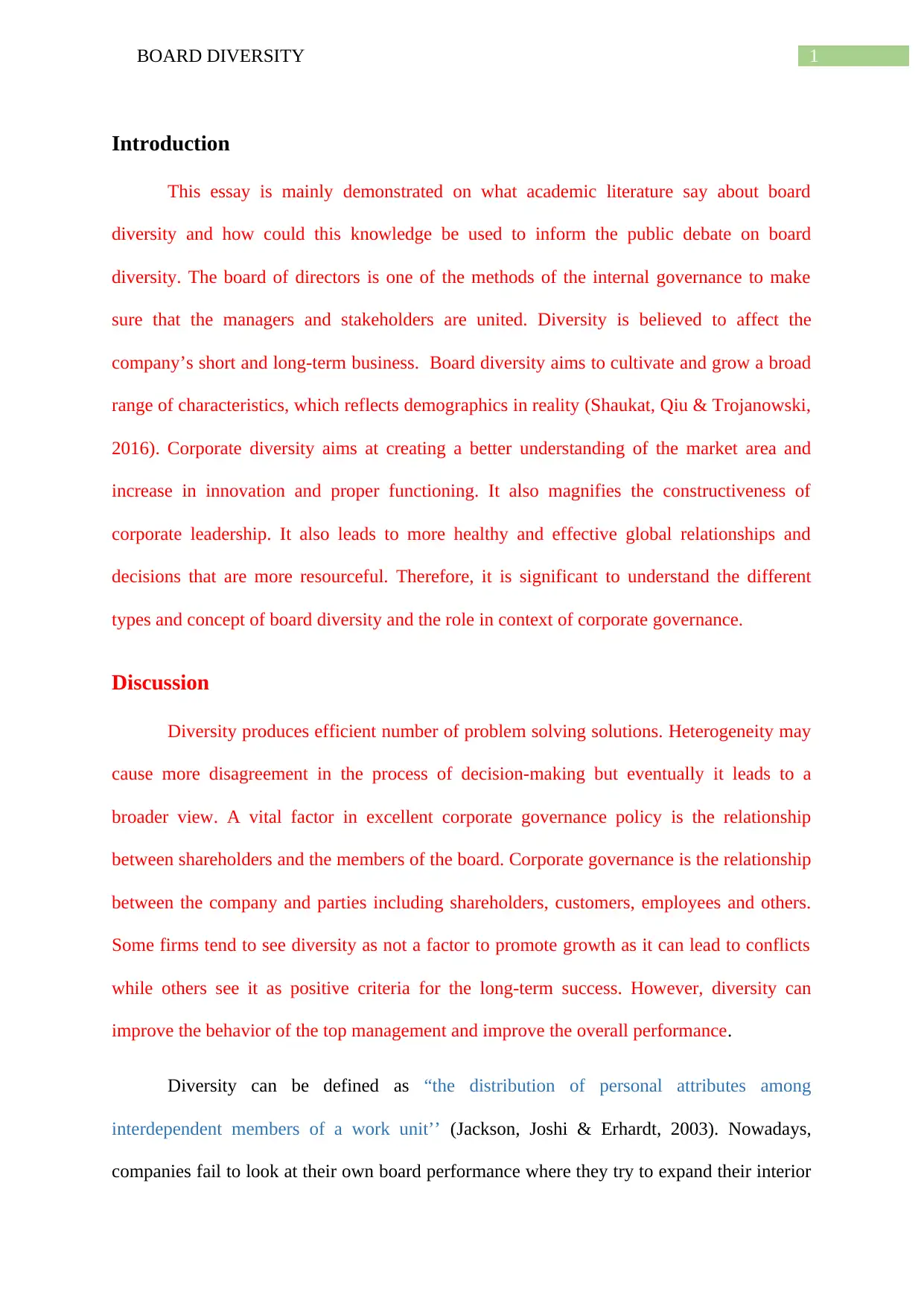
1BOARD DIVERSITY
Introduction
This essay is mainly demonstrated on what academic literature say about board
diversity and how could this knowledge be used to inform the public debate on board
diversity. The board of directors is one of the methods of the internal governance to make
sure that the managers and stakeholders are united. Diversity is believed to affect the
company’s short and long-term business. Board diversity aims to cultivate and grow a broad
range of characteristics, which reflects demographics in reality (Shaukat, Qiu & Trojanowski,
2016). Corporate diversity aims at creating a better understanding of the market area and
increase in innovation and proper functioning. It also magnifies the constructiveness of
corporate leadership. It also leads to more healthy and effective global relationships and
decisions that are more resourceful. Therefore, it is significant to understand the different
types and concept of board diversity and the role in context of corporate governance.
Discussion
Diversity produces efficient number of problem solving solutions. Heterogeneity may
cause more disagreement in the process of decision-making but eventually it leads to a
broader view. A vital factor in excellent corporate governance policy is the relationship
between shareholders and the members of the board. Corporate governance is the relationship
between the company and parties including shareholders, customers, employees and others.
Some firms tend to see diversity as not a factor to promote growth as it can lead to conflicts
while others see it as positive criteria for the long-term success. However, diversity can
improve the behavior of the top management and improve the overall performance.
Diversity can be defined as “the distribution of personal attributes among
interdependent members of a work unit’’ (Jackson, Joshi & Erhardt, 2003). Nowadays,
companies fail to look at their own board performance where they try to expand their interior
Introduction
This essay is mainly demonstrated on what academic literature say about board
diversity and how could this knowledge be used to inform the public debate on board
diversity. The board of directors is one of the methods of the internal governance to make
sure that the managers and stakeholders are united. Diversity is believed to affect the
company’s short and long-term business. Board diversity aims to cultivate and grow a broad
range of characteristics, which reflects demographics in reality (Shaukat, Qiu & Trojanowski,
2016). Corporate diversity aims at creating a better understanding of the market area and
increase in innovation and proper functioning. It also magnifies the constructiveness of
corporate leadership. It also leads to more healthy and effective global relationships and
decisions that are more resourceful. Therefore, it is significant to understand the different
types and concept of board diversity and the role in context of corporate governance.
Discussion
Diversity produces efficient number of problem solving solutions. Heterogeneity may
cause more disagreement in the process of decision-making but eventually it leads to a
broader view. A vital factor in excellent corporate governance policy is the relationship
between shareholders and the members of the board. Corporate governance is the relationship
between the company and parties including shareholders, customers, employees and others.
Some firms tend to see diversity as not a factor to promote growth as it can lead to conflicts
while others see it as positive criteria for the long-term success. However, diversity can
improve the behavior of the top management and improve the overall performance.
Diversity can be defined as “the distribution of personal attributes among
interdependent members of a work unit’’ (Jackson, Joshi & Erhardt, 2003). Nowadays,
companies fail to look at their own board performance where they try to expand their interior
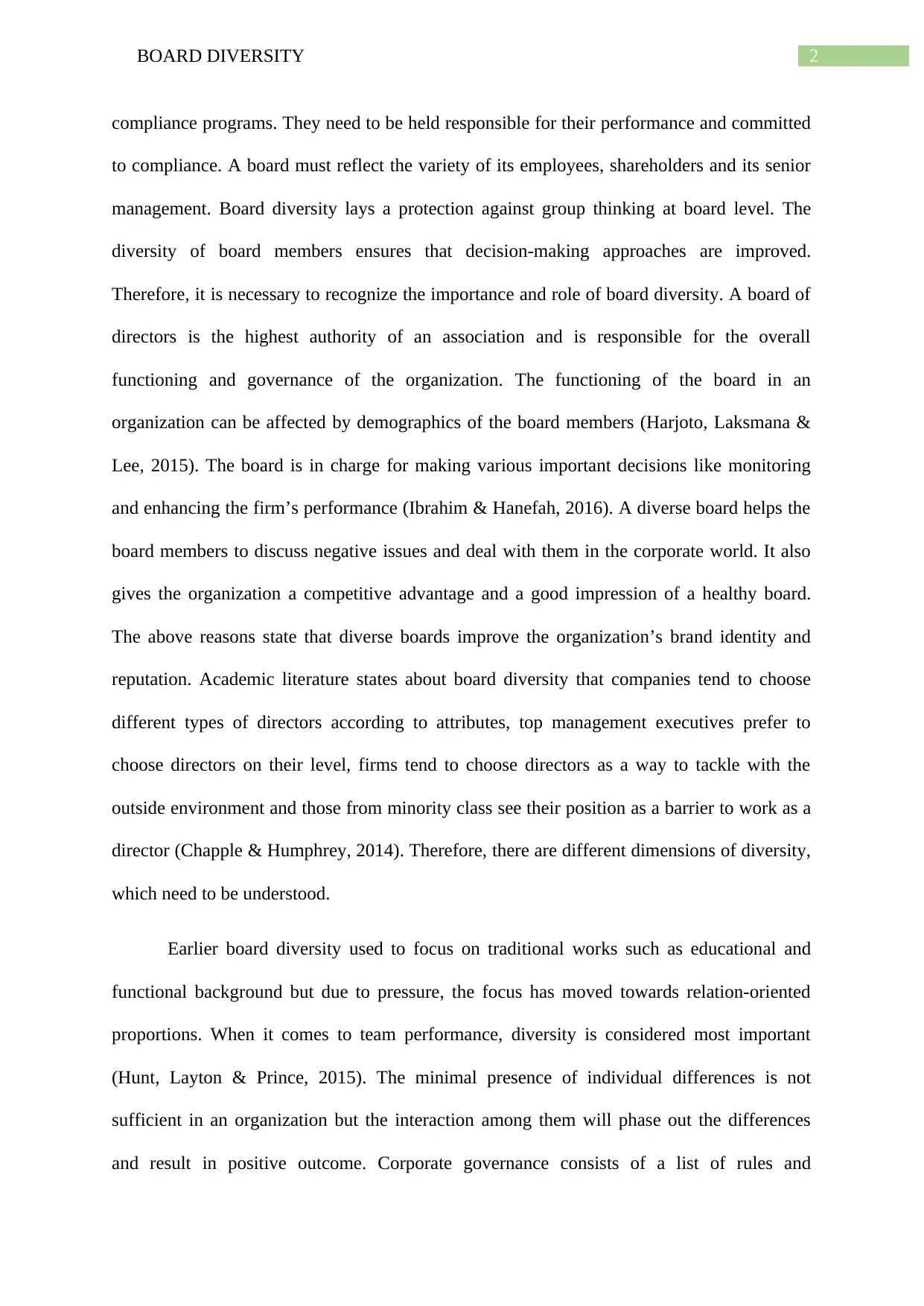
2BOARD DIVERSITY
compliance programs. They need to be held responsible for their performance and committed
to compliance. A board must reflect the variety of its employees, shareholders and its senior
management. Board diversity lays a protection against group thinking at board level. The
diversity of board members ensures that decision-making approaches are improved.
Therefore, it is necessary to recognize the importance and role of board diversity. A board of
directors is the highest authority of an association and is responsible for the overall
functioning and governance of the organization. The functioning of the board in an
organization can be affected by demographics of the board members (Harjoto, Laksmana &
Lee, 2015). The board is in charge for making various important decisions like monitoring
and enhancing the firm’s performance (Ibrahim & Hanefah, 2016). A diverse board helps the
board members to discuss negative issues and deal with them in the corporate world. It also
gives the organization a competitive advantage and a good impression of a healthy board.
The above reasons state that diverse boards improve the organization’s brand identity and
reputation. Academic literature states about board diversity that companies tend to choose
different types of directors according to attributes, top management executives prefer to
choose directors on their level, firms tend to choose directors as a way to tackle with the
outside environment and those from minority class see their position as a barrier to work as a
director (Chapple & Humphrey, 2014). Therefore, there are different dimensions of diversity,
which need to be understood.
Earlier board diversity used to focus on traditional works such as educational and
functional background but due to pressure, the focus has moved towards relation-oriented
proportions. When it comes to team performance, diversity is considered most important
(Hunt, Layton & Prince, 2015). The minimal presence of individual differences is not
sufficient in an organization but the interaction among them will phase out the differences
and result in positive outcome. Corporate governance consists of a list of rules and
compliance programs. They need to be held responsible for their performance and committed
to compliance. A board must reflect the variety of its employees, shareholders and its senior
management. Board diversity lays a protection against group thinking at board level. The
diversity of board members ensures that decision-making approaches are improved.
Therefore, it is necessary to recognize the importance and role of board diversity. A board of
directors is the highest authority of an association and is responsible for the overall
functioning and governance of the organization. The functioning of the board in an
organization can be affected by demographics of the board members (Harjoto, Laksmana &
Lee, 2015). The board is in charge for making various important decisions like monitoring
and enhancing the firm’s performance (Ibrahim & Hanefah, 2016). A diverse board helps the
board members to discuss negative issues and deal with them in the corporate world. It also
gives the organization a competitive advantage and a good impression of a healthy board.
The above reasons state that diverse boards improve the organization’s brand identity and
reputation. Academic literature states about board diversity that companies tend to choose
different types of directors according to attributes, top management executives prefer to
choose directors on their level, firms tend to choose directors as a way to tackle with the
outside environment and those from minority class see their position as a barrier to work as a
director (Chapple & Humphrey, 2014). Therefore, there are different dimensions of diversity,
which need to be understood.
Earlier board diversity used to focus on traditional works such as educational and
functional background but due to pressure, the focus has moved towards relation-oriented
proportions. When it comes to team performance, diversity is considered most important
(Hunt, Layton & Prince, 2015). The minimal presence of individual differences is not
sufficient in an organization but the interaction among them will phase out the differences
and result in positive outcome. Corporate governance consists of a list of rules and
⊘ This is a preview!⊘
Do you want full access?
Subscribe today to unlock all pages.

Trusted by 1+ million students worldwide
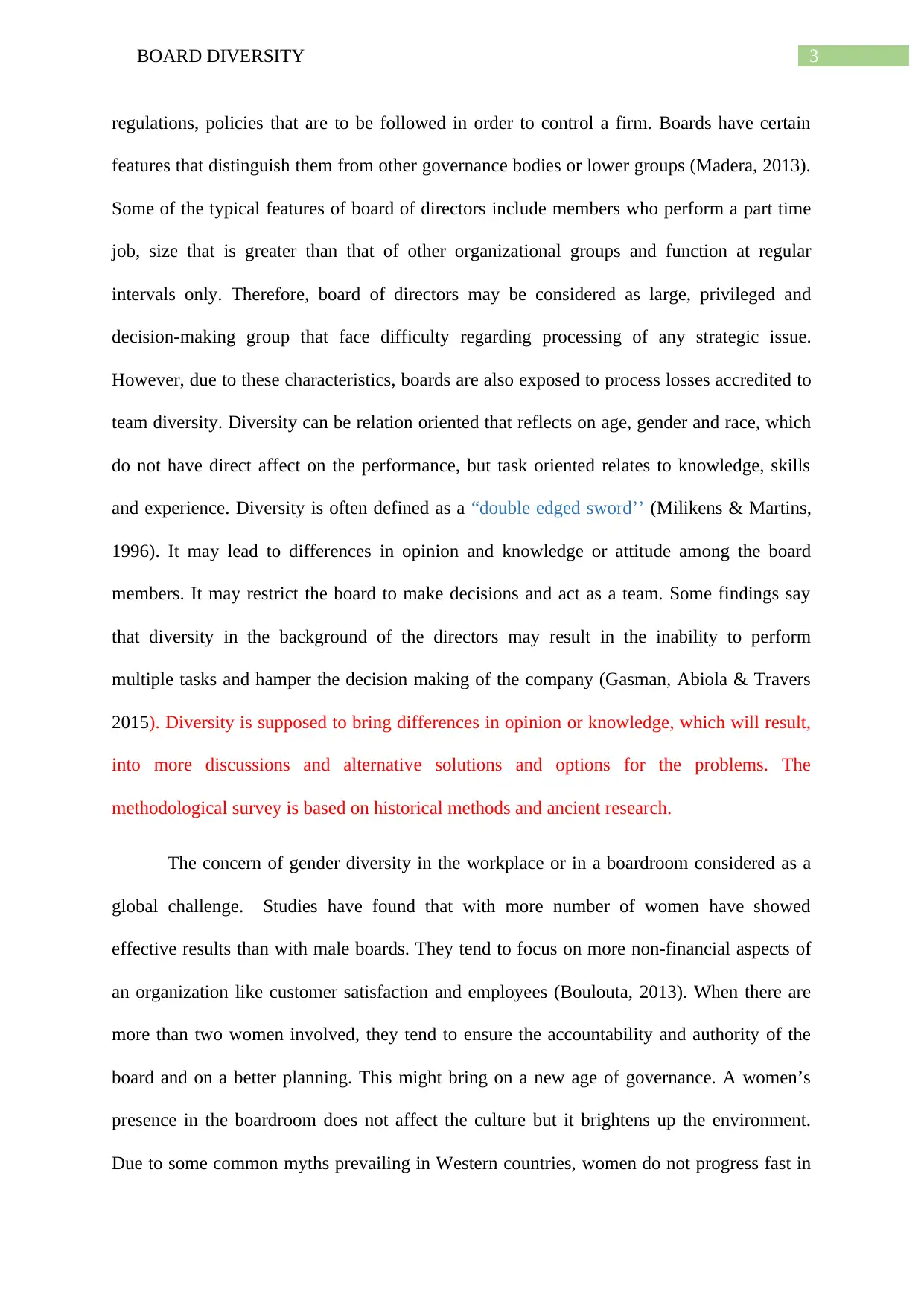
3BOARD DIVERSITY
regulations, policies that are to be followed in order to control a firm. Boards have certain
features that distinguish them from other governance bodies or lower groups (Madera, 2013).
Some of the typical features of board of directors include members who perform a part time
job, size that is greater than that of other organizational groups and function at regular
intervals only. Therefore, board of directors may be considered as large, privileged and
decision-making group that face difficulty regarding processing of any strategic issue.
However, due to these characteristics, boards are also exposed to process losses accredited to
team diversity. Diversity can be relation oriented that reflects on age, gender and race, which
do not have direct affect on the performance, but task oriented relates to knowledge, skills
and experience. Diversity is often defined as a “double edged sword’’ (Milikens & Martins,
1996). It may lead to differences in opinion and knowledge or attitude among the board
members. It may restrict the board to make decisions and act as a team. Some findings say
that diversity in the background of the directors may result in the inability to perform
multiple tasks and hamper the decision making of the company (Gasman, Abiola & Travers
2015). Diversity is supposed to bring differences in opinion or knowledge, which will result,
into more discussions and alternative solutions and options for the problems. The
methodological survey is based on historical methods and ancient research.
The concern of gender diversity in the workplace or in a boardroom considered as a
global challenge. Studies have found that with more number of women have showed
effective results than with male boards. They tend to focus on more non-financial aspects of
an organization like customer satisfaction and employees (Boulouta, 2013). When there are
more than two women involved, they tend to ensure the accountability and authority of the
board and on a better planning. This might bring on a new age of governance. A women’s
presence in the boardroom does not affect the culture but it brightens up the environment.
Due to some common myths prevailing in Western countries, women do not progress fast in
regulations, policies that are to be followed in order to control a firm. Boards have certain
features that distinguish them from other governance bodies or lower groups (Madera, 2013).
Some of the typical features of board of directors include members who perform a part time
job, size that is greater than that of other organizational groups and function at regular
intervals only. Therefore, board of directors may be considered as large, privileged and
decision-making group that face difficulty regarding processing of any strategic issue.
However, due to these characteristics, boards are also exposed to process losses accredited to
team diversity. Diversity can be relation oriented that reflects on age, gender and race, which
do not have direct affect on the performance, but task oriented relates to knowledge, skills
and experience. Diversity is often defined as a “double edged sword’’ (Milikens & Martins,
1996). It may lead to differences in opinion and knowledge or attitude among the board
members. It may restrict the board to make decisions and act as a team. Some findings say
that diversity in the background of the directors may result in the inability to perform
multiple tasks and hamper the decision making of the company (Gasman, Abiola & Travers
2015). Diversity is supposed to bring differences in opinion or knowledge, which will result,
into more discussions and alternative solutions and options for the problems. The
methodological survey is based on historical methods and ancient research.
The concern of gender diversity in the workplace or in a boardroom considered as a
global challenge. Studies have found that with more number of women have showed
effective results than with male boards. They tend to focus on more non-financial aspects of
an organization like customer satisfaction and employees (Boulouta, 2013). When there are
more than two women involved, they tend to ensure the accountability and authority of the
board and on a better planning. This might bring on a new age of governance. A women’s
presence in the boardroom does not affect the culture but it brightens up the environment.
Due to some common myths prevailing in Western countries, women do not progress fast in
Paraphrase This Document
Need a fresh take? Get an instant paraphrase of this document with our AI Paraphraser
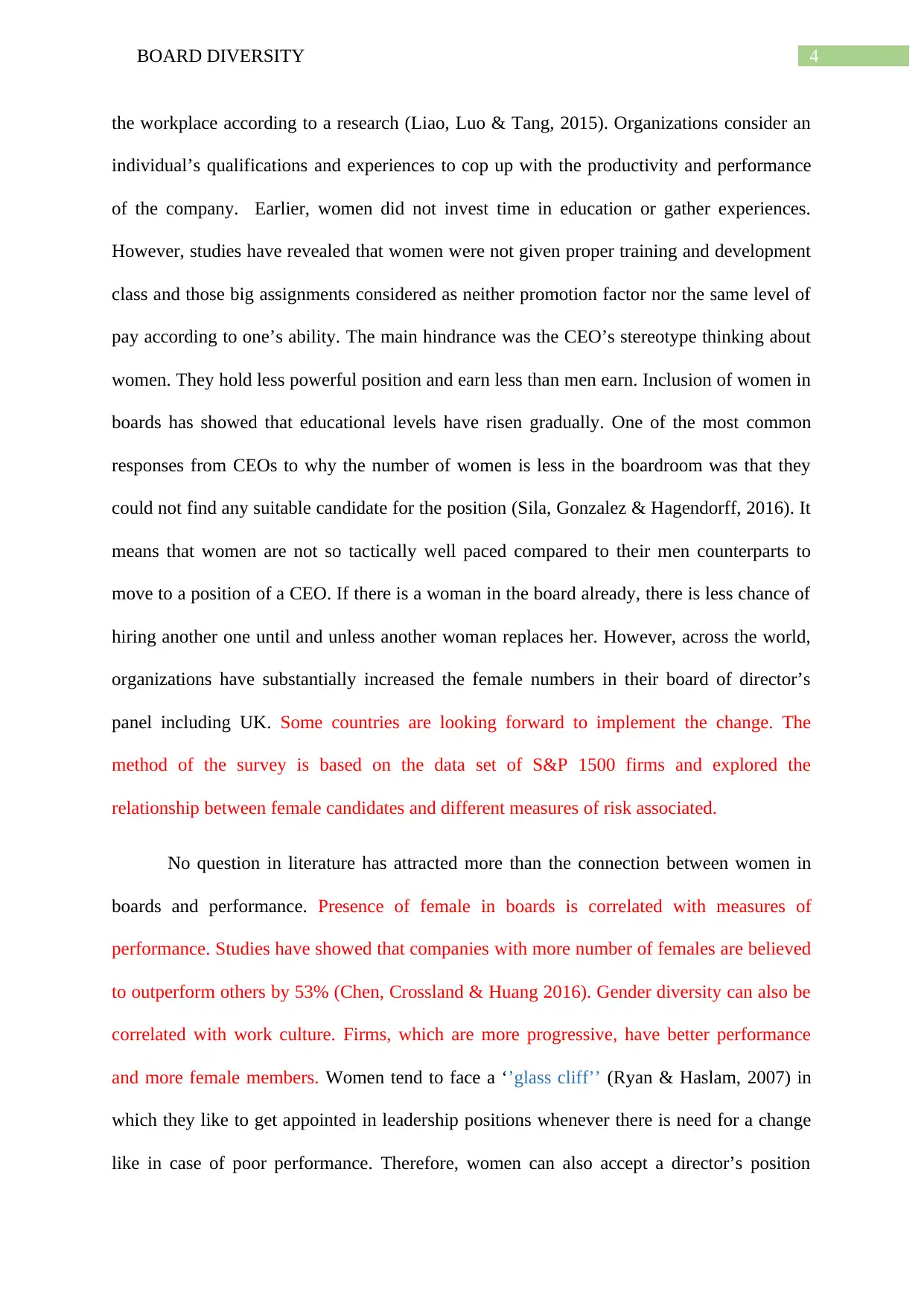
4BOARD DIVERSITY
the workplace according to a research (Liao, Luo & Tang, 2015). Organizations consider an
individual’s qualifications and experiences to cop up with the productivity and performance
of the company. Earlier, women did not invest time in education or gather experiences.
However, studies have revealed that women were not given proper training and development
class and those big assignments considered as neither promotion factor nor the same level of
pay according to one’s ability. The main hindrance was the CEO’s stereotype thinking about
women. They hold less powerful position and earn less than men earn. Inclusion of women in
boards has showed that educational levels have risen gradually. One of the most common
responses from CEOs to why the number of women is less in the boardroom was that they
could not find any suitable candidate for the position (Sila, Gonzalez & Hagendorff, 2016). It
means that women are not so tactically well paced compared to their men counterparts to
move to a position of a CEO. If there is a woman in the board already, there is less chance of
hiring another one until and unless another woman replaces her. However, across the world,
organizations have substantially increased the female numbers in their board of director’s
panel including UK. Some countries are looking forward to implement the change. The
method of the survey is based on the data set of S&P 1500 firms and explored the
relationship between female candidates and different measures of risk associated.
No question in literature has attracted more than the connection between women in
boards and performance. Presence of female in boards is correlated with measures of
performance. Studies have showed that companies with more number of females are believed
to outperform others by 53% (Chen, Crossland & Huang 2016). Gender diversity can also be
correlated with work culture. Firms, which are more progressive, have better performance
and more female members. Women tend to face a ‘’glass cliff’’ (Ryan & Haslam, 2007) in
which they like to get appointed in leadership positions whenever there is need for a change
like in case of poor performance. Therefore, women can also accept a director’s position
the workplace according to a research (Liao, Luo & Tang, 2015). Organizations consider an
individual’s qualifications and experiences to cop up with the productivity and performance
of the company. Earlier, women did not invest time in education or gather experiences.
However, studies have revealed that women were not given proper training and development
class and those big assignments considered as neither promotion factor nor the same level of
pay according to one’s ability. The main hindrance was the CEO’s stereotype thinking about
women. They hold less powerful position and earn less than men earn. Inclusion of women in
boards has showed that educational levels have risen gradually. One of the most common
responses from CEOs to why the number of women is less in the boardroom was that they
could not find any suitable candidate for the position (Sila, Gonzalez & Hagendorff, 2016). It
means that women are not so tactically well paced compared to their men counterparts to
move to a position of a CEO. If there is a woman in the board already, there is less chance of
hiring another one until and unless another woman replaces her. However, across the world,
organizations have substantially increased the female numbers in their board of director’s
panel including UK. Some countries are looking forward to implement the change. The
method of the survey is based on the data set of S&P 1500 firms and explored the
relationship between female candidates and different measures of risk associated.
No question in literature has attracted more than the connection between women in
boards and performance. Presence of female in boards is correlated with measures of
performance. Studies have showed that companies with more number of females are believed
to outperform others by 53% (Chen, Crossland & Huang 2016). Gender diversity can also be
correlated with work culture. Firms, which are more progressive, have better performance
and more female members. Women tend to face a ‘’glass cliff’’ (Ryan & Haslam, 2007) in
which they like to get appointed in leadership positions whenever there is need for a change
like in case of poor performance. Therefore, women can also accept a director’s position
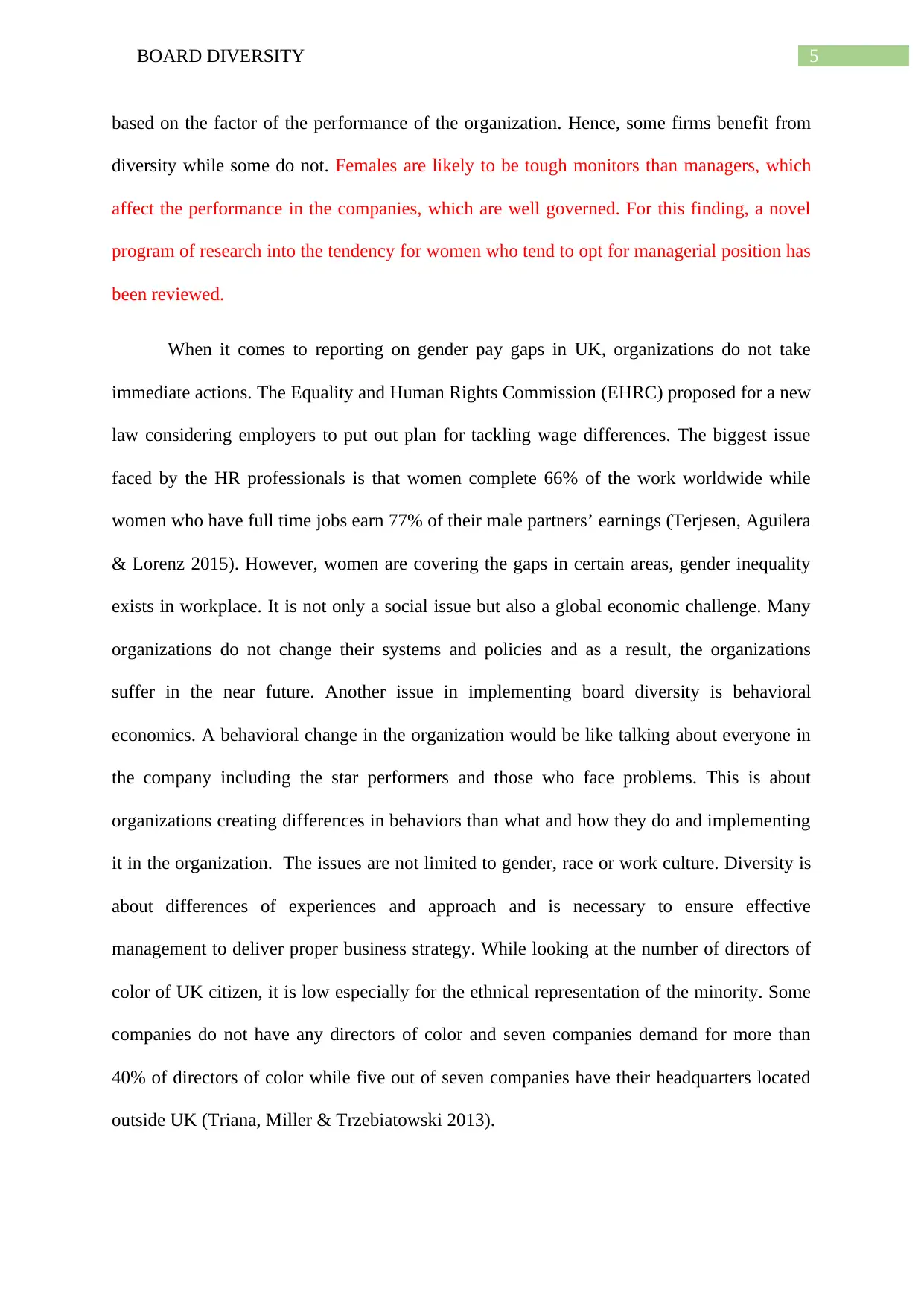
5BOARD DIVERSITY
based on the factor of the performance of the organization. Hence, some firms benefit from
diversity while some do not. Females are likely to be tough monitors than managers, which
affect the performance in the companies, which are well governed. For this finding, a novel
program of research into the tendency for women who tend to opt for managerial position has
been reviewed.
When it comes to reporting on gender pay gaps in UK, organizations do not take
immediate actions. The Equality and Human Rights Commission (EHRC) proposed for a new
law considering employers to put out plan for tackling wage differences. The biggest issue
faced by the HR professionals is that women complete 66% of the work worldwide while
women who have full time jobs earn 77% of their male partners’ earnings (Terjesen, Aguilera
& Lorenz 2015). However, women are covering the gaps in certain areas, gender inequality
exists in workplace. It is not only a social issue but also a global economic challenge. Many
organizations do not change their systems and policies and as a result, the organizations
suffer in the near future. Another issue in implementing board diversity is behavioral
economics. A behavioral change in the organization would be like talking about everyone in
the company including the star performers and those who face problems. This is about
organizations creating differences in behaviors than what and how they do and implementing
it in the organization. The issues are not limited to gender, race or work culture. Diversity is
about differences of experiences and approach and is necessary to ensure effective
management to deliver proper business strategy. While looking at the number of directors of
color of UK citizen, it is low especially for the ethnical representation of the minority. Some
companies do not have any directors of color and seven companies demand for more than
40% of directors of color while five out of seven companies have their headquarters located
outside UK (Triana, Miller & Trzebiatowski 2013).
based on the factor of the performance of the organization. Hence, some firms benefit from
diversity while some do not. Females are likely to be tough monitors than managers, which
affect the performance in the companies, which are well governed. For this finding, a novel
program of research into the tendency for women who tend to opt for managerial position has
been reviewed.
When it comes to reporting on gender pay gaps in UK, organizations do not take
immediate actions. The Equality and Human Rights Commission (EHRC) proposed for a new
law considering employers to put out plan for tackling wage differences. The biggest issue
faced by the HR professionals is that women complete 66% of the work worldwide while
women who have full time jobs earn 77% of their male partners’ earnings (Terjesen, Aguilera
& Lorenz 2015). However, women are covering the gaps in certain areas, gender inequality
exists in workplace. It is not only a social issue but also a global economic challenge. Many
organizations do not change their systems and policies and as a result, the organizations
suffer in the near future. Another issue in implementing board diversity is behavioral
economics. A behavioral change in the organization would be like talking about everyone in
the company including the star performers and those who face problems. This is about
organizations creating differences in behaviors than what and how they do and implementing
it in the organization. The issues are not limited to gender, race or work culture. Diversity is
about differences of experiences and approach and is necessary to ensure effective
management to deliver proper business strategy. While looking at the number of directors of
color of UK citizen, it is low especially for the ethnical representation of the minority. Some
companies do not have any directors of color and seven companies demand for more than
40% of directors of color while five out of seven companies have their headquarters located
outside UK (Triana, Miller & Trzebiatowski 2013).
⊘ This is a preview!⊘
Do you want full access?
Subscribe today to unlock all pages.

Trusted by 1+ million students worldwide
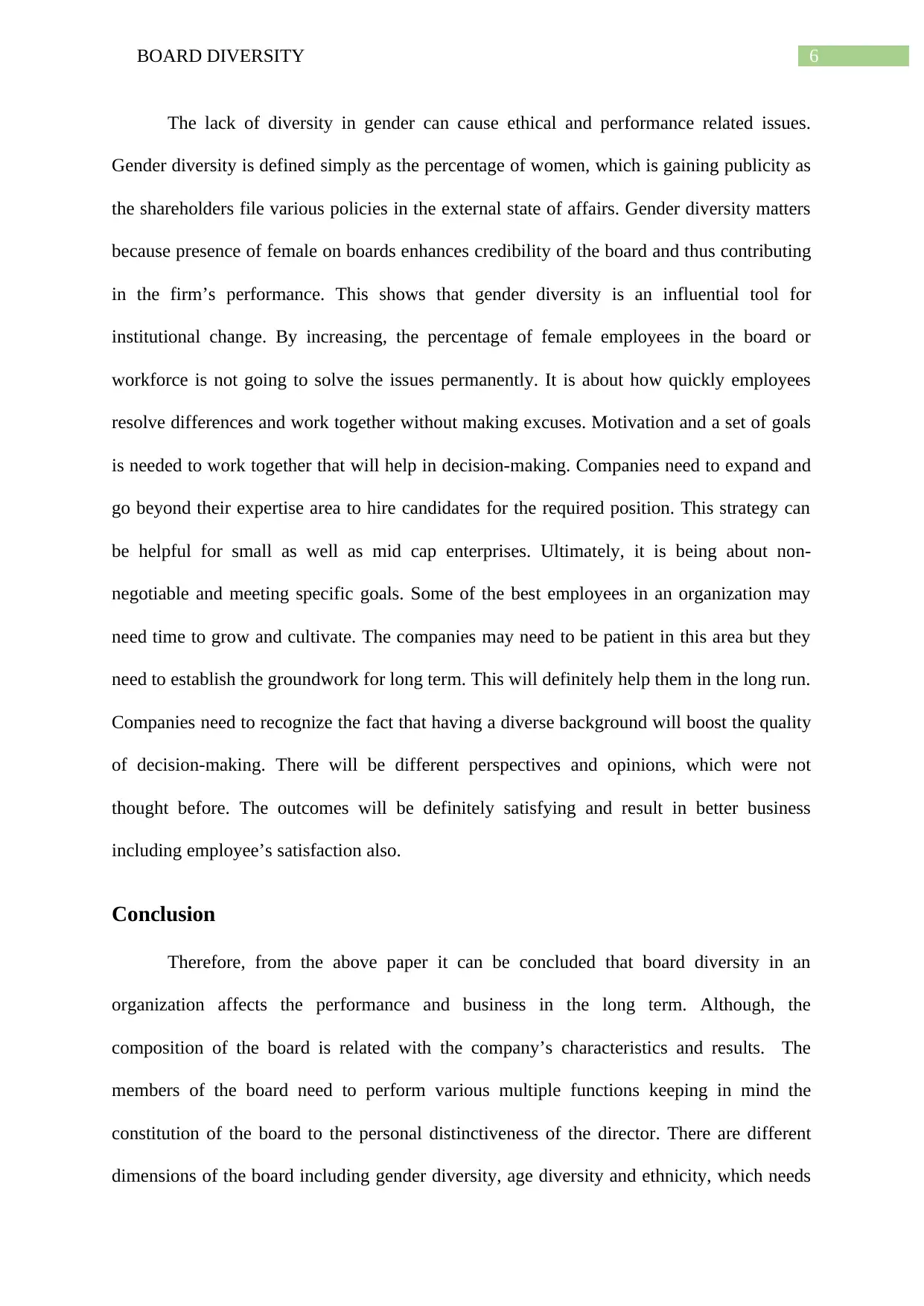
6BOARD DIVERSITY
The lack of diversity in gender can cause ethical and performance related issues.
Gender diversity is defined simply as the percentage of women, which is gaining publicity as
the shareholders file various policies in the external state of affairs. Gender diversity matters
because presence of female on boards enhances credibility of the board and thus contributing
in the firm’s performance. This shows that gender diversity is an influential tool for
institutional change. By increasing, the percentage of female employees in the board or
workforce is not going to solve the issues permanently. It is about how quickly employees
resolve differences and work together without making excuses. Motivation and a set of goals
is needed to work together that will help in decision-making. Companies need to expand and
go beyond their expertise area to hire candidates for the required position. This strategy can
be helpful for small as well as mid cap enterprises. Ultimately, it is being about non-
negotiable and meeting specific goals. Some of the best employees in an organization may
need time to grow and cultivate. The companies may need to be patient in this area but they
need to establish the groundwork for long term. This will definitely help them in the long run.
Companies need to recognize the fact that having a diverse background will boost the quality
of decision-making. There will be different perspectives and opinions, which were not
thought before. The outcomes will be definitely satisfying and result in better business
including employee’s satisfaction also.
Conclusion
Therefore, from the above paper it can be concluded that board diversity in an
organization affects the performance and business in the long term. Although, the
composition of the board is related with the company’s characteristics and results. The
members of the board need to perform various multiple functions keeping in mind the
constitution of the board to the personal distinctiveness of the director. There are different
dimensions of the board including gender diversity, age diversity and ethnicity, which needs
The lack of diversity in gender can cause ethical and performance related issues.
Gender diversity is defined simply as the percentage of women, which is gaining publicity as
the shareholders file various policies in the external state of affairs. Gender diversity matters
because presence of female on boards enhances credibility of the board and thus contributing
in the firm’s performance. This shows that gender diversity is an influential tool for
institutional change. By increasing, the percentage of female employees in the board or
workforce is not going to solve the issues permanently. It is about how quickly employees
resolve differences and work together without making excuses. Motivation and a set of goals
is needed to work together that will help in decision-making. Companies need to expand and
go beyond their expertise area to hire candidates for the required position. This strategy can
be helpful for small as well as mid cap enterprises. Ultimately, it is being about non-
negotiable and meeting specific goals. Some of the best employees in an organization may
need time to grow and cultivate. The companies may need to be patient in this area but they
need to establish the groundwork for long term. This will definitely help them in the long run.
Companies need to recognize the fact that having a diverse background will boost the quality
of decision-making. There will be different perspectives and opinions, which were not
thought before. The outcomes will be definitely satisfying and result in better business
including employee’s satisfaction also.
Conclusion
Therefore, from the above paper it can be concluded that board diversity in an
organization affects the performance and business in the long term. Although, the
composition of the board is related with the company’s characteristics and results. The
members of the board need to perform various multiple functions keeping in mind the
constitution of the board to the personal distinctiveness of the director. There are different
dimensions of the board including gender diversity, age diversity and ethnicity, which needs
Paraphrase This Document
Need a fresh take? Get an instant paraphrase of this document with our AI Paraphraser

7BOARD DIVERSITY
to be ruled out for the proper and biased functioning of the organization. The study on board
diversity is a way to understand the advantages of diversity in the work unit and issues of
corporate governance. Data suggests that females are underrepresented in the workplace in
comparison to the male workers and therefore their percentage is less in the board of
directors. Therefore, these are valuable lessons in context of a healthy business.
to be ruled out for the proper and biased functioning of the organization. The study on board
diversity is a way to understand the advantages of diversity in the work unit and issues of
corporate governance. Data suggests that females are underrepresented in the workplace in
comparison to the male workers and therefore their percentage is less in the board of
directors. Therefore, these are valuable lessons in context of a healthy business.
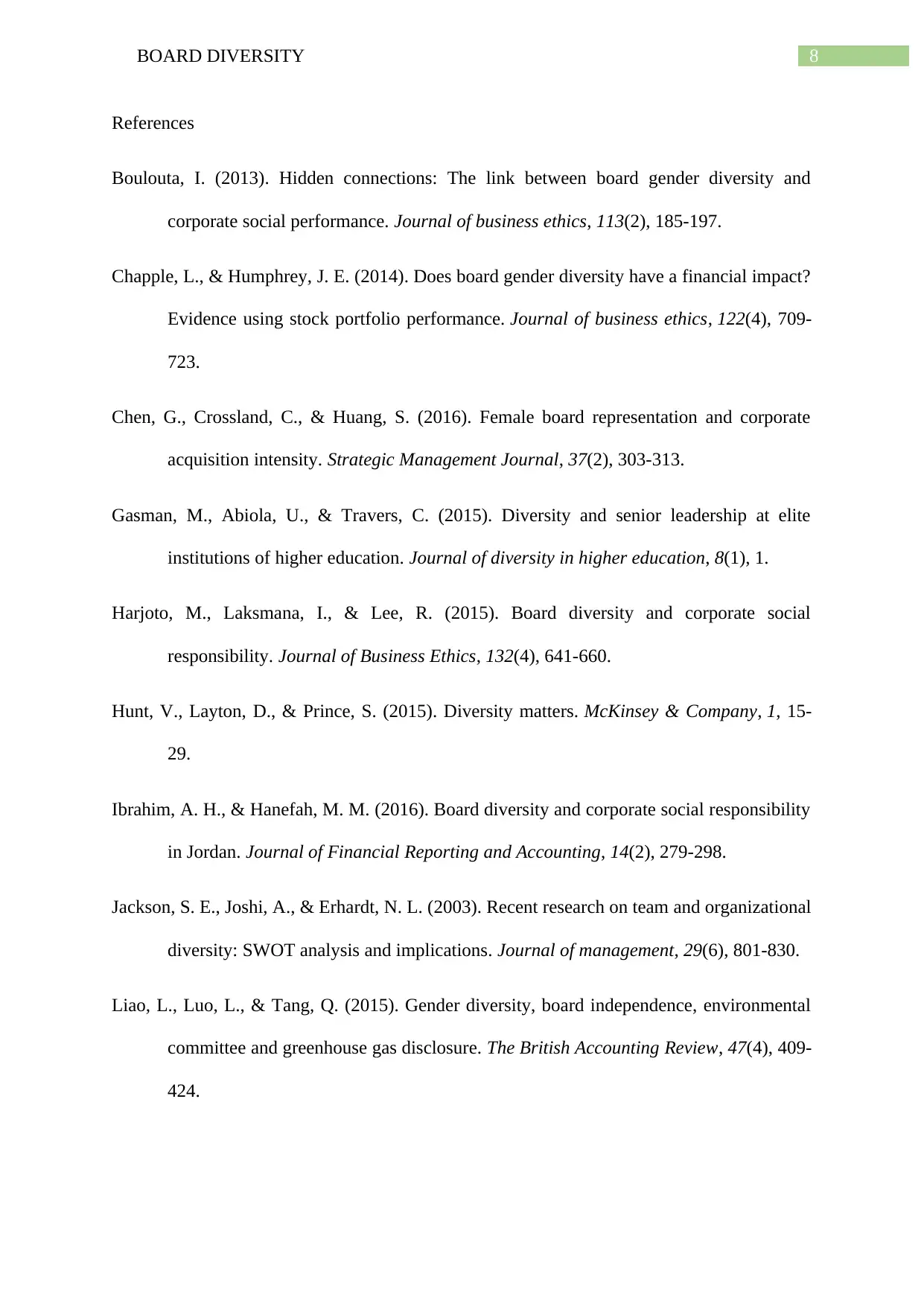
8BOARD DIVERSITY
References
Boulouta, I. (2013). Hidden connections: The link between board gender diversity and
corporate social performance. Journal of business ethics, 113(2), 185-197.
Chapple, L., & Humphrey, J. E. (2014). Does board gender diversity have a financial impact?
Evidence using stock portfolio performance. Journal of business ethics, 122(4), 709-
723.
Chen, G., Crossland, C., & Huang, S. (2016). Female board representation and corporate
acquisition intensity. Strategic Management Journal, 37(2), 303-313.
Gasman, M., Abiola, U., & Travers, C. (2015). Diversity and senior leadership at elite
institutions of higher education. Journal of diversity in higher education, 8(1), 1.
Harjoto, M., Laksmana, I., & Lee, R. (2015). Board diversity and corporate social
responsibility. Journal of Business Ethics, 132(4), 641-660.
Hunt, V., Layton, D., & Prince, S. (2015). Diversity matters. McKinsey & Company, 1, 15-
29.
Ibrahim, A. H., & Hanefah, M. M. (2016). Board diversity and corporate social responsibility
in Jordan. Journal of Financial Reporting and Accounting, 14(2), 279-298.
Jackson, S. E., Joshi, A., & Erhardt, N. L. (2003). Recent research on team and organizational
diversity: SWOT analysis and implications. Journal of management, 29(6), 801-830.
Liao, L., Luo, L., & Tang, Q. (2015). Gender diversity, board independence, environmental
committee and greenhouse gas disclosure. The British Accounting Review, 47(4), 409-
424.
References
Boulouta, I. (2013). Hidden connections: The link between board gender diversity and
corporate social performance. Journal of business ethics, 113(2), 185-197.
Chapple, L., & Humphrey, J. E. (2014). Does board gender diversity have a financial impact?
Evidence using stock portfolio performance. Journal of business ethics, 122(4), 709-
723.
Chen, G., Crossland, C., & Huang, S. (2016). Female board representation and corporate
acquisition intensity. Strategic Management Journal, 37(2), 303-313.
Gasman, M., Abiola, U., & Travers, C. (2015). Diversity and senior leadership at elite
institutions of higher education. Journal of diversity in higher education, 8(1), 1.
Harjoto, M., Laksmana, I., & Lee, R. (2015). Board diversity and corporate social
responsibility. Journal of Business Ethics, 132(4), 641-660.
Hunt, V., Layton, D., & Prince, S. (2015). Diversity matters. McKinsey & Company, 1, 15-
29.
Ibrahim, A. H., & Hanefah, M. M. (2016). Board diversity and corporate social responsibility
in Jordan. Journal of Financial Reporting and Accounting, 14(2), 279-298.
Jackson, S. E., Joshi, A., & Erhardt, N. L. (2003). Recent research on team and organizational
diversity: SWOT analysis and implications. Journal of management, 29(6), 801-830.
Liao, L., Luo, L., & Tang, Q. (2015). Gender diversity, board independence, environmental
committee and greenhouse gas disclosure. The British Accounting Review, 47(4), 409-
424.
⊘ This is a preview!⊘
Do you want full access?
Subscribe today to unlock all pages.

Trusted by 1+ million students worldwide

9BOARD DIVERSITY
Madera, J. M. (2013). Best practices in diversity management in customer service
organizations: an investigation of top companies cited by Diversity Inc. Cornell
Hospitality Quarterly, 54(2), 124-135.
Milliken, F. J., & Martins, L. L. (1996). Searching for common threads: Understanding the
multiple effects of diversity in organizational groups. Academy of management
review, 21(2), 402-433.
Ryan, M. K., & Haslam, S. A. (2007). The glass cliff: Exploring the dynamics surrounding
the appointment of women to precarious leadership positions. Academy of
Management Review, 32(2), 549-572.
Shaukat, A., Qiu, Y., & Trojanowski, G. (2016). Board attributes, corporate social
responsibility strategy, and corporate environmental and social performance. Journal
of Business Ethics, 135(3), 569-585.
Sila, V., Gonzalez, A., & Hagendorff, J. (2016). Women on board: Does boardroom gender
diversity affect firm risk?. Journal of Corporate Finance, 36, 26-53.
Terjesen, S., Aguilera, R. V., & Lorenz, R. (2015). Legislating a woman’s seat on the board:
Institutional factors driving gender quotas for boards of directors. Journal of Business
Ethics, 128(2), 233-251.
Triana, M. D. C., Miller, T. L., & Trzebiatowski, T. M. (2013). The double-edged nature of
board gender diversity: Diversity, firm performance, and the power of women
directors as predictors of strategic change. Organization Science, 25(2), 609-632.
Madera, J. M. (2013). Best practices in diversity management in customer service
organizations: an investigation of top companies cited by Diversity Inc. Cornell
Hospitality Quarterly, 54(2), 124-135.
Milliken, F. J., & Martins, L. L. (1996). Searching for common threads: Understanding the
multiple effects of diversity in organizational groups. Academy of management
review, 21(2), 402-433.
Ryan, M. K., & Haslam, S. A. (2007). The glass cliff: Exploring the dynamics surrounding
the appointment of women to precarious leadership positions. Academy of
Management Review, 32(2), 549-572.
Shaukat, A., Qiu, Y., & Trojanowski, G. (2016). Board attributes, corporate social
responsibility strategy, and corporate environmental and social performance. Journal
of Business Ethics, 135(3), 569-585.
Sila, V., Gonzalez, A., & Hagendorff, J. (2016). Women on board: Does boardroom gender
diversity affect firm risk?. Journal of Corporate Finance, 36, 26-53.
Terjesen, S., Aguilera, R. V., & Lorenz, R. (2015). Legislating a woman’s seat on the board:
Institutional factors driving gender quotas for boards of directors. Journal of Business
Ethics, 128(2), 233-251.
Triana, M. D. C., Miller, T. L., & Trzebiatowski, T. M. (2013). The double-edged nature of
board gender diversity: Diversity, firm performance, and the power of women
directors as predictors of strategic change. Organization Science, 25(2), 609-632.
1 out of 10
Related Documents
Your All-in-One AI-Powered Toolkit for Academic Success.
+13062052269
info@desklib.com
Available 24*7 on WhatsApp / Email
![[object Object]](/_next/static/media/star-bottom.7253800d.svg)
Unlock your academic potential
Copyright © 2020–2025 A2Z Services. All Rights Reserved. Developed and managed by ZUCOL.





